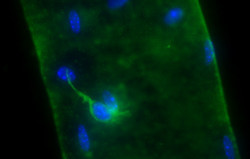Stem cells in muscular maintenance and regeneration
Skeletal muscle contains a specialised population of undifferentiated stem cells known as satellite cells (SCs). In response to injury, SCs rapidly activate, proliferate and then undergo terminal differentiation. However, the precise molecular mechanisms implicated in the regulation of SC fate decisions are still largely unknown. In answer to this, the EU-funded SATCELLOMICS (Integrated signalling networks in muscle stem cells: cell fate regulation by heparan sulfates) project set out to test the hypothesis that the extracellular environment influences disease and ageing. Initially, the consortium studied how the composition of the muscle extracellular environment changes in degenerative diseases such as muscular dystrophy. During muscular dystrophy, stem cells lose their regenerative capacity, a phenomenon most likely linked with a defective environment. To delineate the alterations associated with a dystrophic environment, researchers analysed the composition of the muscle extracellular environment in dystrophic and healthy mice. Using mass spectrometry, they identified a class of proteins which accumulated during muscular dystrophy progression and affected muscle stem cells. Addition of these proteins to healthy stem cells in vitro dramatically impaired cell proliferation and differentiation, clearly underscoring the role of the environment on stem cells. Furthermore, the consortium analysed the gene expression profile of stem cells attached to their normal niche or on their own in a petri dish. Significant changes were observed in signalling pathways implicated in cell-environment communication, cell proliferation and differentiation. Taken together, the findings of the SATCELLOMICS study demonstrate that the extracellular environment controls muscle stem cell homeostasis and fate decisions. They also pave the way for manipulating the regenerative capacity of these cells through alteration of the extracellular environment, potentially with a targeted pharmacological approach.







